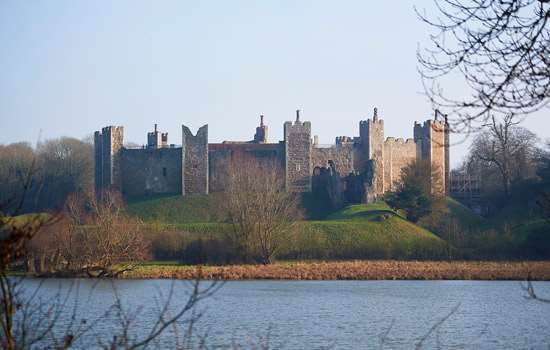ST AUGUSTINE’S ABBEY, CANTERBURY, KENT
What happened here? The roots of English Christianity were planted
Nominated by: Dr Steven Brindle
In 597, Augustine arrived in south-east Britain, charged by Pope Gregory with converting the pagan King Æthelberht of Kent, the most powerful of the Anglo-Saxon monarchs. That task completed, the following year Augustine founded the abbey – originally dedicated to St Peter and St Paul – which became the cradle of revived English Christianity. ‘This site speaks of a very big theme, a very big process in history – the conversion of the pagan kingdoms of England to Christianity,’ says head historic properties curator Dr Jeremy Ashbee.
‘What Augustine’s settlement did was to start a tradition of literate clerics living in England,’ agrees senior properties historian Dr Steven Brindle. ‘You could almost say it was the start of recorded history, not in these islands, but of the English people.’
Today, you can roam the ruins of Norman and later medieval structures built on the site of Augustine’s original abbey, and spy remnants of Anglo-Saxon structures in the atmospheric grounds.
Visit St Augustine's AbbeyCHAPTER HOUSE AT WESTMINSTER ABBEY, LONDON
What happened here? The modern English parliament was shaped
Nominated by: Dr Jeremy Ashbee
Built between 1246 and 1255 on the orders of King Henry III, the Chapter House was ostensibly a present for the Benedictine monks of the adjacent abbey – but that was not the monarch’s primary objective. ‘We now think that his motivation was much more tied to the idea of parliament,’ says Jeremy Ashbee. ‘He was creating the grand assembly room where he would appear in his full kingly state and speak to the nation.’ The origins of the English parliament have long been debated, but it’s clear that the design of this building was connected with the way Henry planned to conduct such meetings.
Find out morePEVENSEY CASTLE, EAST SUSSEX
What happened here? Duke William launched his conquest of England
Nominated by: Dr Jeremy Ashbee
Every student knows about the pivotal clash at Hastings on 14 October 1066. But it was at Pevensey Bay, 10 miles south-west of the battle site, that the Norman Duke William landed his troops on 28 September, establishing his base camp before marching off to face King Harold II and his Anglo-Saxons. ‘At Pevensey, you can still see things William would have seen,’ says Jeremy Ashbee. ‘You can see why William, having landed there, would say: “This is where we’ll camp for the first night.”’ Pevensey remained important after William’s invasion, and today you can admire the remains of the mighty Norman keep and gatehouse built after he had secured his crown.
Visit Pevensey CastleKENWOOD, HAMPSTEAD, LONDON
What happened here? Lord Mansfield deliberated a case that played a key role in the abolition of slavery
Nominated by: Dr Dominique Bouchard
This grand neoclassical villa is now a familiar landmark on Hampstead Heath, admired as a wonderful example of the work of 18th-century architect Robert Adam, and for its fine art collection featuring several Old Masters. But Kenwood is arguably most important as the home of William Murray, 1st Earl of Mansfield, portrayed by Tom Wilkinson in the 2014 film Belle. In 1772, Mansfield – then Lord Chief Justice of the King’s Bench – ruled on the case of Somerset vs Stewart, brought on behalf of an enslaved African man detained after escaping in England. ‘Mansfield’s judgment declared that there was no basis in common law for slavery,’ says Dr Dominique Bouchard, head of learning and interpretation, ‘and was a fundamental part – certainly an important legal step – in the abolition of the slave trade.’ Though it was another 35 years before the slave trade was abolished by the UK parliament, the contribution of Mansfield’s judgement is clear, asserting of slavery that, ‘It is so odious that nothing can be suffered to support it, but positive law.’
Visit Kenwood
IRON BRIDGE, SHROPSHIRE
What happened here? Abraham Darby III kick-started the Industrial Revolution
Nominated by: Dr Steven Brindle
Admiring the graceful semicircle of the Iron Bridge reflected in the River Severn, it takes a degree of imagination to picture this site surrounded by forges and factories. Just two centuries ago, that was the scene greeting visitors to Coalbrookdale, heartland of ironmaking in England. Its apogee survives in the form of that 30m-long arch, completed in 1779 by Abraham Darby III, whose grandfather perfected coke-fuelled iron smelting 70 years earlier. ‘This was the moment at which iron went from being something used at the scale of a blacksmith’s forge to a structure spanning a major river,’ explains Steven Brindle. ‘This was the first bridge to be made entirely of iron in world history; a great landmark in the development of Britain.’ Today, as well as crossing the bridge itself, visitors to Coalbrookdale can explore an extensive roster of fascinating museums.
Visit Iron BridgeTHE CENOTAPH, LONDON
What happened here? The way Britons think about war and remembrance changed
Nominated by: Dr Dominique Bouchard
The most striking thing about Sir Edwin Lutyen’s monument in Whitehall is its simplicity. The white Portland stone column bears only carved wreaths, a symbolic tomb and three words: ‘The Glorious Dead’. ‘Its construction changed the way that people across the UK think about remembrance and war,’ says Dominique Bouchard. ‘There are really wonderful photographs from the peace day parade on 19 July 1919, showing thousands of soldiers returning from war walking past the Cenotaph; I think it was a transformational moment in terms of the country’s psyche.’ The original monument, constructed with wood and canvas, was only temporary – but the powerful public response prompted the construction of Lutyen’s permanent replacement, completed in time for the Armistice Day parade in 1920.
Find out more
Down House, Kent
What happened here? Darwin revolutionised our understanding of evolution
Nominated by: Dr Steven Brindle
When the renowned naturalist first set eyes on this property in the Kent countryside in 1842, he was underwhelmed by its aesthetic charms; Darwin wrote that it was ‘ugly… neither old nor new’. But Down House provided what he most needed at that time: space to think – and his thinking during his 40 years living here proved pivotal to modern biology. ‘This was where he wrote all of his books, including On the Origin of Species, published in 1859,’ says Steven Brindle. ‘Darwin used the garden and the landscape around him as a kind of open-air laboratory. The observations he carried out here were as important as those he’d carried out while a naturalist on board HMS Beagle in the 1830s.’ Today, you can visit the study where he wrote that groundbreaking work, explore his family’s rooms and greenhouse, and stroll through the gardens where Darwin paced while formulating his theories.
Visit the Home of Charles Darwin, Down HouseDOVER CASTLE, KENT
What happened here? The evacuation of British and allied troops from Dunkirk during the Second World War was coordinated
Nominated by: Dr Jeremy Ashbee
This spot has been fortified for many centuries, probably since the Iron Age, and you can still admire its Roman lighthouse, Anglo-Saxon church and the tower of Henry II’s 12th-century palace. But it’s what lies beneath that has arguably been most significant historically. A warren of tunnels was excavated during the Napoleonic Wars and extended during the Second World War, when they housed the command centre that controlled naval operations in the Channel. ‘In that pivotal moment of 1940, when Operation Dynamo – the Dunkirk evacuation – was organised from there, Dover symbolised Britain’s defiance of the Third Reich,’ says Jeremy Ashbee. Dover’s tunnels now offer an immersive experience for visitors, who can learn about the planning of the rescue operation from Dunkirk.
Visit Dover CastleYork Cold War Bunker, North Yorkshire
What happened here? Real people prepared for nuclear attack and its immediate consequences
Nominated by: Dr Dominique Bouchard
One of our most modern sites is also one of our most chilling. ‘In a sense, nothing happened here but it was built in anticipation of national and worldwide disaster,’ says Dominique Bouchard. ‘This was where the Royal Observer Corps would have been stationed. In the event of nuclear attack or fallout, they would have taken readings of the radiation outside the bunker. Readings from around 40 tiny bunkers across Yorkshire would have been collected and sent to UK Warning and Monitoring Organisation for analysis and passed to civil and military authorities.’ It’s a surprisingly human place to visit, too. ‘People would have said goodbye to their families and headed for the bunker, while their homes outside might have been destroyed and their families perished, depending on the proximity of the nuclear attack. It’s not hard to imagine yourself being one of those people, and to think about what that must have been like. The bunker has a really tactile aesthetic and it’s full of things we recognise, yet it tells a really harrowing story of what might have been.’
Find out more


